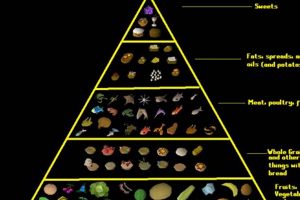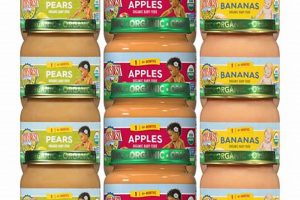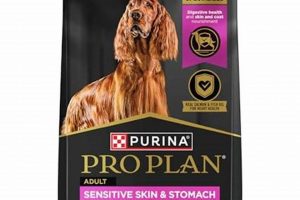Optimal sustenance for Corydoras catfish encompasses a variety of food sources designed to meet their specific dietary needs as bottom-dwelling scavengers. This diet should include sinking pellets or wafers formulated for bottom feeders, supplemented with occasional live or frozen foods. A well-balanced nutritional intake promotes their overall health and vitality.
Providing appropriate nutrition is crucial for the longevity and well-being of these popular aquarium inhabitants. Adequate feeding practices support healthy growth, vibrant coloration, and robust immune systems, contributing to a thriving aquarium environment. Historically, understanding the dietary needs of captive fish has evolved, leading to commercially available foods specifically formulated for species like Corydoras catfish.
The following sections will delve into the specifics of suitable commercially prepared options, the role of live and frozen alternatives, and guidelines for proper feeding frequency and quantity, ensuring these fascinating creatures receive the necessary nutrition to flourish.
Guidance on Optimal Corydoras Catfish Nutrition
The following are several guidelines for ensuring Corydoras catfish receive appropriate nutrition, maximizing their health and well-being within the aquarium environment.
Tip 1: Select sinking food specifically formulated for bottom feeders. These formulations are designed to reach the substrate where Corydoras catfish forage and provide a balanced nutrient profile.
Tip 2: Supplement the prepared diet with occasional live or frozen food. Bloodworms, daphnia, and brine shrimp offer essential proteins and trace elements, enhancing the nutritional diversity of the diet.
Tip 3: Avoid overfeeding. Provide only the amount of food that can be consumed within a few minutes. Excess food accumulation contributes to water quality degradation.
Tip 4: Observe the feeding behavior of the catfish. Monitor their activity and body condition to adjust food portions appropriately. A healthy Corydoras catfish should appear robust, but not overly bloated.
Tip 5: Introduce variety into the diet. Rotate between different brands and types of sinking food to ensure a comprehensive range of nutrients is provided.
Tip 6: Consider the size of the pellets or wafers. Larger Corydoras species may require larger food items, while smaller species benefit from finely ground options.
Tip 7: Ensure that food reaches the bottom quickly. In community tanks with faster-feeding fish, use a feeding tube to direct food specifically towards the substrate, minimizing competition.
Consistent attention to these dietary guidelines contributes to the long-term health and vitality of Corydoras catfish within the aquarium setting.
The subsequent sections will address potential issues related to diet and offer solutions for maintaining optimal Corydoras catfish health through proper nutrition.
1. Sinking Pellets/Wafers
Sinking pellets and wafers represent a cornerstone in the nutritional management of Corydoras catfish within an aquarium setting. Their formulation is specifically designed to cater to the bottom-feeding habits of these fish, ensuring that sustenance is readily available in their natural foraging zone. These commercially prepared foods provide a concentrated source of essential nutrients, contributing significantly to the overall health and vitality of Corydoras species.
- Nutritional Completeness
Sinking pellets and wafers are typically formulated to provide a balanced diet, encompassing proteins, carbohydrates, fats, and essential vitamins and minerals. This comprehensive nutritional profile addresses the diverse dietary requirements of Corydoras catfish, promoting optimal growth, coloration, and immune system function. For instance, quality pellets often contain spirulina for enhanced color and stabilized vitamin C for immune support.
- Physical Properties
The sinking nature of these foods is crucial for their effectiveness. Unlike flake foods, which primarily float on the water surface, sinking pellets and wafers readily descend to the substrate, allowing Corydoras catfish to access them without undue competition from other tank inhabitants. The density and shape of these food items are engineered to maintain their integrity as they sink, preventing rapid disintegration and minimizing water pollution.
- Dietary Enrichment
While sinking pellets and wafers serve as a foundational diet, they can be supplemented with other food sources to enhance nutritional diversity. Combining these prepared foods with occasional offerings of live or frozen foods, such as bloodworms or daphnia, provides a broader spectrum of essential nutrients and stimulates natural foraging behaviors. This dietary enrichment promotes both physical and psychological well-being in Corydoras catfish.
- Water Quality Impact
The selection of high-quality sinking pellets and wafers directly impacts water quality within the aquarium. Formulations that minimize binding agents and fillers reduce the production of excess waste, thereby mitigating the risk of ammonia and nitrite spikes. Choosing products with a low ash content further contributes to a cleaner aquatic environment, benefiting the overall health of the entire aquarium ecosystem.
The considerations outlined above highlight the pivotal role of sinking pellets and wafers in the dietary management of Corydoras catfish. Prioritizing nutritionally complete, physically appropriate, and environmentally conscious formulations ensures that these popular aquarium inhabitants receive the necessary sustenance to thrive in captivity. Regular monitoring of feeding behavior and water quality provides valuable insights for adjusting dietary strategies and maintaining optimal Corydoras health.
2. Live/Frozen Foods
Live and frozen food sources represent a crucial complement to commercially prepared diets for Corydoras catfish, contributing significantly to their overall health and well-being. The inclusion of such food options provides essential nutrients often lacking in processed alternatives and stimulates natural foraging behaviors. The nutritional benefits directly impact the health of Corydoras, affecting factors such as coloration, breeding success, and disease resistance. The absence of live or frozen foods can lead to nutritional deficiencies, affecting their vitality. Bloodworms, daphnia, and brine shrimp are common examples that deliver high-protein content and essential fatty acids, promoting healthy growth and development.
The administration of live or frozen food also has practical applications within an aquarium setting. For instance, introducing live blackworms into the substrate encourages natural digging behaviors in Corydoras, enriching their environment and providing mental stimulation. Furthermore, these foods can be used as a conditioning tool prior to breeding attempts, increasing the likelihood of successful spawning. Selecting smaller-sized options, such as micro worms or baby brine shrimp, is important for younger Corydoras catfish to ensure easy consumption. The selection process should consider the food source, its nutritional profile, and the fish’s specific needs.
In summary, live and frozen foods play a fundamental role in optimizing the nutritional intake of Corydoras catfish. Their inclusion alongside commercially prepared diets addresses the potential for nutritional deficiencies and promotes species-appropriate behaviors. While these options offer distinct advantages, responsible husbandry necessitates careful consideration of food source, portion control, and sanitation to maintain water quality and prevent the introduction of pathogens into the aquarium environment. Therefore, the use of live and frozen foods is an integral aspect of a comprehensive strategy for providing the most suitable sustenance to Corydoras catfish.
3. Protein Richness
Protein richness is a critical element in determining the nutritional value of food sources for Corydoras catfish. As omnivorous scavengers, these fish require an adequate protein intake to support growth, tissue repair, and overall physiological function. The following points detail the importance of protein content in dietary options for Corydoras.
- Growth and Development
Protein serves as the fundamental building block for tissues and organs. Young, growing Corydoras catfish require a higher percentage of protein in their diet to facilitate proper development. Deficiencies in protein intake during this phase can lead to stunted growth, skeletal deformities, and compromised immune function. A diet consisting of sinking pellets with a protein content of 30-40% is typically recommended for juvenile Corydoras.
- Reproductive Health
Protein is essential for the production of eggs and sperm. During breeding periods, adult Corydoras catfish require an increased protein intake to support gamete development. Live or frozen foods, such as bloodworms or daphnia, which are naturally high in protein, can be offered to condition breeding pairs. Failure to provide adequate protein during this time can result in reduced fertility and poor egg quality.
- Immune System Function
Proteins are integral to the synthesis of antibodies and other immune components. A protein-rich diet supports a robust immune system, enabling Corydoras catfish to effectively combat infections and diseases. Supplementing their diet with occasional feedings of live foods like blackworms, which contain immunostimulatory compounds, can further enhance their resistance to pathogens.
- Digestibility and Absorption
The quality and digestibility of protein sources are also important factors. Protein derived from animal sources, such as fish meal, is generally more digestible for Corydoras catfish than plant-based proteins. Selecting foods with highly digestible protein sources ensures that the fish can efficiently absorb and utilize the nutrients, maximizing the benefits of a protein-rich diet. Hydrolyzed protein sources are sometimes included in premium foods to enhance digestibility.
In conclusion, a diet rich in high-quality protein is indispensable for maintaining the health and vitality of Corydoras catfish. Careful consideration of protein content and digestibility is necessary when selecting appropriate food options. Integrating both commercially prepared foods with adequate protein levels and occasional supplementation with live or frozen protein sources supports optimal growth, reproduction, and immune function in these popular aquarium inhabitants.
4. Variety
The inclusion of variety in the diet of Corydoras catfish is not merely a matter of preference but a fundamental aspect of ensuring optimal health and nutritional well-being. A monotonous diet, even if seemingly complete, can lead to deficiencies and a lack of essential micronutrients. Variety mimics the natural foraging habits of these fish, contributing to their psychological well-being and stimulating their appetite.
- Nutritional Completeness through Diversity
Different food sources offer distinct nutrient profiles. Relying solely on a single type of sinking pellet, for example, might lead to imbalances in vitamin or mineral intake. Incorporating live or frozen foods such as bloodworms, daphnia, and brine shrimp provides a broader spectrum of essential nutrients, contributing to a more balanced and complete diet. A diet that incorporates various food sources supports immune system function and overall vitality.
- Stimulation of Natural Foraging Behavior
In their natural habitat, Corydoras catfish are opportunistic scavengers, consuming a wide range of invertebrates, algae, and detritus. Replicating this dietary diversity in captivity encourages their natural foraging behaviors. Introducing varied food items of different textures and sizes provides mental stimulation and prevents boredom, promoting a healthier and more active lifestyle. Varying the location of food placement within the aquarium can further enhance the foraging experience.
- Prevention of Dietary Selectivity
A consistent diet of the same food can lead to dietary selectivity, where fish become accustomed to a single food source and refuse others. This can complicate feeding regimens and make it difficult to introduce new or more nutritious food options. Offering a variety of foods from an early age helps prevent this behavior, ensuring that Corydoras catfish remain receptive to different food items throughout their lives. Introducing novel food options in small quantities and observing their acceptance can help expand their dietary repertoire.
- Enhanced Palatability and Appetite
Variety in the diet can significantly enhance palatability and stimulate appetite. Fish, like other animals, experience sensory fatigue when consistently fed the same food. Introducing different flavors, textures, and aromas can reignite their interest in feeding and encourage consumption. The addition of live or frozen foods often elicits a strong feeding response due to their natural attractants. A healthy appetite is essential for ensuring adequate nutrient intake and maintaining optimal health.
The multifaceted benefits of dietary variety underscore its importance in providing optimal sustenance to Corydoras catfish. Employing a diverse feeding strategy, which encompasses sinking pellets, live and frozen foods, and occasional vegetable matter, is essential for maintaining their health, stimulating natural behaviors, and preventing nutritional deficiencies. The implementation of varied feeding schedules contributes to an environment that mimics the natural conditions encountered by these fascinating fish, ensuring their well-being within the aquarium setting.
5. Size Appropriateness
Size appropriateness is a critical factor when selecting sustenance for Corydoras catfish. The dimensions of food items must correlate with the fish’s mouth size to facilitate ingestion and digestion, directly impacting nutrient uptake and overall health. Food particles that are too large can lead to choking or incomplete consumption, potentially causing malnutrition. Conversely, excessively small particles may disperse rapidly, becoming inaccessible to the bottom-dwelling Corydoras, or contribute to water quality degradation through uneaten remnants. For example, larger Corydoras species, such as Corydoras aeneus, can readily consume sinking pellets designed for small bottom feeders, whereas smaller species, such as Corydoras habrosus, require crumbled pellets or micro-sized sinking foods to ensure effective feeding.
Practical application of this principle involves careful observation of feeding behavior. If Corydoras are seen struggling to ingest food or ignoring it altogether, the size of the food item should be adjusted accordingly. The selection of food products should consider the average size of the Corydoras species being maintained, with adjustments made for individual variations within the population. Many commercially available sinking pellets and wafers are offered in different size ranges, allowing aquarists to customize their feeding regimen. Moreover, when supplementing with live or frozen foods, such as bloodworms or daphnia, selecting appropriately sized portions is essential. Larger bloodworms can be chopped into smaller segments, while daphnia are generally small enough for even the smallest Corydoras species.
In conclusion, size appropriateness is an essential aspect of providing optimal nutrition to Corydoras catfish. The selection of appropriately sized food items ensures efficient ingestion, digestion, and nutrient absorption, directly contributing to their health and well-being. By carefully considering the dimensions of food particles and observing the feeding behavior of the fish, aquarists can mitigate the risks of malnutrition and water quality issues, fostering a thriving environment for these popular aquarium inhabitants.
6. Minimal Waste
The concept of minimal waste is intrinsically linked to the selection of optimal nutrition for Corydoras catfish. The generation of excessive waste products from uneaten food has direct consequences for water quality, potentially leading to elevated levels of ammonia, nitrites, and nitrates. These compounds, if unchecked, are detrimental to the health of all aquarium inhabitants, including the Corydoras. The selection of food that promotes minimal waste is therefore a critical component of responsible Corydoras husbandry.
The characteristics of food that contribute to reduced waste production include high digestibility, appropriate particle size, and low levels of indigestible fillers. Highly digestible food ensures that a greater proportion of the ingested material is absorbed by the fish, reducing the amount of waste excreted. For example, sinking pellets formulated with high-quality protein sources and minimal plant-based fillers generate less waste compared to cheaper alternatives with a higher proportion of indigestible ingredients. Furthermore, the selection of appropriately sized food prevents uneaten portions from accumulating on the substrate, where they decompose and contribute to water quality deterioration. Overfeeding, regardless of the food’s inherent digestibility, also leads to increased waste production. A practical approach involves observing the Corydoras during feeding and adjusting the quantity of food provided to ensure that all portions are consumed within a few minutes. Selecting slowly dissolving sinking wafers rather than readily crumbling flakes can also minimize particulate waste.
In summary, the minimization of waste products is a significant consideration when choosing appropriate sustenance for Corydoras catfish. By selecting highly digestible food in appropriate portions, and minimizing indigestible fillers, aquarists can maintain optimal water quality and promote the health and longevity of their Corydoras. This practice exemplifies a responsible approach to aquarium management, prioritizing the well-being of the fish and the stability of the aquatic environment. Recognizing and mitigating waste production through informed food selection is a fundamental aspect of Corydoras care.
Frequently Asked Questions Regarding Optimal Nutrition for Corydoras Catfish
The following section addresses common inquiries pertaining to appropriate dietary practices for Corydoras catfish, aiming to clarify misconceptions and provide valuable insights.
Question 1: What constitutes the most suitable food for Corydoras catfish?
A balanced diet for Corydoras catfish comprises sinking pellets or wafers specifically formulated for bottom-feeding fish, supplemented with occasional offerings of live or frozen foods such as bloodworms or daphnia. This approach ensures adequate protein intake and nutritional diversity.
Question 2: How frequently should Corydoras catfish be fed?
Corydoras catfish should typically be fed once or twice daily, providing only the amount of food that can be consumed within a few minutes. Overfeeding can lead to water quality issues and should be avoided.
Question 3: Is it necessary to supplement commercially prepared food with live or frozen options?
While commercially prepared foods provide a foundational diet, supplementing with live or frozen foods enhances nutritional diversity and stimulates natural foraging behaviors, contributing to the overall health and well-being of Corydoras catfish.
Question 4: Are there specific ingredients to avoid in Corydoras catfish food?
Foods containing excessive fillers, artificial colors, and preservatives should be avoided. Opt for options with high-quality protein sources and minimal indigestible components to promote optimal digestion and minimize waste production.
Question 5: Do different species of Corydoras catfish have varying dietary requirements?
While the fundamental dietary principles remain consistent across Corydoras species, the size of the food particles should be adjusted based on the size of the fish. Smaller species require smaller food items to ensure efficient ingestion.
Question 6: How does food size impact the health of Corydoras catfish?
Appropriate food particle size is crucial for preventing choking and ensuring efficient nutrient absorption. Food that is too large can be difficult to ingest, while overly small particles may disperse rapidly, becoming inaccessible to the bottom-dwelling Corydoras.
The insights provided above underscore the importance of informed dietary choices in maintaining the health and vitality of Corydoras catfish. Adherence to these guidelines contributes to a thriving aquarium environment.
The subsequent sections will delve into specific considerations related to the diagnosis and management of common health issues in Corydoras catfish.
Optimal Nutrition for Corydoras Catfish
The preceding exploration of “best food for cory catfish” elucidates the complex interplay between dietary components and the well-being of these popular aquarium inhabitants. Key considerations include selecting sinking food specifically formulated for bottom feeders, supplementing with live or frozen options, and carefully managing portion sizes to minimize waste. Protein richness, variety, and size appropriateness represent critical factors in ensuring optimal nutrition.
Ultimately, informed dietary choices represent a cornerstone of responsible Corydoras husbandry. Prioritizing species-appropriate nutrition fosters a thriving aquatic environment and contributes to the long-term health and vitality of these fascinating fish. Continuously refining feeding strategies based on careful observation remains essential for adapting to the evolving needs of Corydoras catfish within the aquarium setting.







